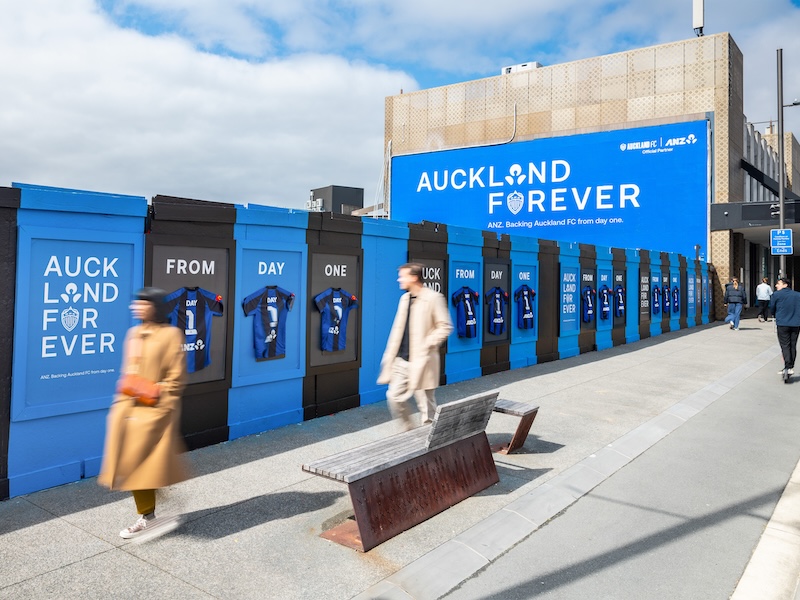Since its launch in October 2021, oOh!media’s pDOOH (programmatic Digital Out of Home) offering has garnered significant attention, positioning itself as a growth opportunity for the Out of Home (OOH) industry. As the market embraces the potential of pDOOH, StopPress caught up with Rick Goodwin, Product Innovation and Solutions Director at oOh!media NZ, and Richard Thompson from media agency D3 to address the questions and curiosities that arise out of this space.
With unparalleled national reach that includes over 88 percent of both metro and regional New Zealanders through a network of nearly 4,000 touchpoints, oOh!media continues to evolve the OOH industry in Aotearoa.
Offering two environmental types for pDOOH: Street Furniture (330+ Small Format Digital screens) and Retail Centres (41 centres with 450+ Small and Large Format Digital screens), oOh!media’s scale enables them to serve advertisers at various stages of the conversion funnel: from top-of-funnel broadcast awareness, mid-funnel audience intenders, and bottom of the funnel path-to-purchase and point-of-purchase messaging.
According to Goodwin, oOh!media has expanded its offering to a completely new market and customer base over the past 18 months, as well as expanding oOh!’s supply side platform (SSP) partnerships to include both Vistar and Hivestack to provide further options for advertising partners.
“In addition to traditional media agencies and advertisers, oOh! is now engaged in trading with agencies, advertisers, and brands that are primarily digitally native, granting them access to the Out of Home (OOH) ecosystem through pDOOH,” he says.
“These digital-savvy traders are effectively leveraging the new buying capabilities provided. They possess expertise in personalised targeting and messaging strategies commonly employed in online advertising, which they are now applying to the OOH medium in a tactical manner that combines the advantages of one-to-one and one-to-many communication approaches.”
The integration of offline and online activities boosts overall effectiveness and allows advertisers to establish a connection between campaign performance and out-of-home (OOH) advertising, thanks to the metrics available online.
As part of its work introducing pDOOH to the market, oOh!media has been emphasising the shift from ‘asset-based’ buying to ‘audience-based’ buying and the associated differences.
“Advertisers are now competing for share-of-time on screen vs. a guaranteed spot in each screen rotation. Understanding this is crucial for advertisers, as it affects the visibility of campaigns, and the associated frequency of contact,” says Goodwin.
“We saw a lot of advertisers dipping their toe in the water over the Test & Learn period. However, some advertisers were stretching budgets far too thinly – which impacted the campaign visibility, if comparing to a traditional OOH campaign.”
To address this, oOh!media has developed a pDOOH Campaign Planning tool. Advertisers can provide their campaign investment, days and time of day they wish to target, planned screen volume, and more – and the Planning Tool will reflect the share of voice they will receive. This allows oOh!media to provide recommendations on optimising the investment for increased visibility or alternative options for better results.
For media agencies like D3 that buy space on behalf of clients, pDOOH is another useful tool in their toolkit.
“We see the opportunity to merge the best of broadcast OOH with the targeting capabilities of digital. We’ve pointed a lot of our skillsets in the digital space around data and audience targeting through to this channel and really seeing the benefits of it,” says Co-Founder and Partner at D3, Richard Thompson.
Programmatic DOOH enables a combination of traditional and targeted approaches, ensuring the right message reaches the right audience. By leveraging programmatic capabilities, advertisers can achieve greater intensity and relevance in their OOH advertising, whether through location-based targeting or time-based campaigns. This approach adds a layer of flexibility and precision to complement the broader reach of traditional broadcast strategies.
“The real benefit is to be able to focus in on the core audience and provide that real intensity both with the audience, at the right time, and the ability to be really agile with our messaging. Being able to put the right message at the right time and being able to change that out,” Thompson says.
This also means that D3 can seamlessly connect real-world exposure with digital intensity by utilising OOH placements to target individuals, leveraging their device’s exposure to that location to re-target them in digital channels throughout the day. This approach combines programmatic OOH impact with the ability to drive frequency in digital channels, resulting in measurable responses.
“The challenge with some of the programmatic activity at the moment is sometimes more around guaranteed availability of inventory, but also, not all activity is digitally enabled at the moment. Not all locations are digital.
“What we try to do is have a broadcast layer of activity, where relevant, and to treat that much more as an efficiency reach play. This is really complemented by the programmatic DOOH piece, which gives us intensity in the key areas.
“It works almost a layer below the top of the funnel,” he adds. “It works in that slightly more mid-funnel and provides targeted activity for those that are most relevant.”
Programmatic DOOH not only allows for the initial impact but also capitalises on the frequency and reach achievable in the digital realm, ultimately leading to measurable responses. By strategically combining the power of physical placements with digital precision, marketers can optimise their campaigns by delivering targeted messages throughout an individual’s day, maximising the potential for engagement and conversion.
This combination of offline and online advertising realms offers the opportunity to enhance brand awareness, capture consumer attention, and drive tangible results in today’s increasingly interconnected world.





















Discussion about this post